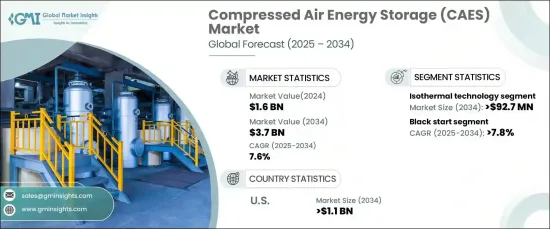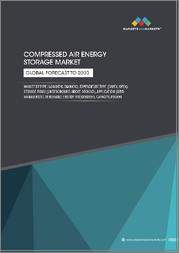
|
시장보고서
상품코드
1667090
세계의 압축 공기 에너지 저장(CAES) 시장 기회, 성장 촉진요인, 산업 동향 분석 및 예측(2025-2034년)Compressed Air Energy Storage (CAES) Market Opportunity, Growth Drivers, Industry Trend Analysis, and Forecast 2025 - 2034 |
||||||
세계 압축 공기 에너지 저장(CAES) 시장은 2024년 시장 규모가 16억 달러로 추정되며, 2025-2034년 연평균 7.6%의 견조한 성장세를 보일 것으로 예상됩니다.
풍력 및 태양광과 같은 재생에너지로의 전환이 가속화됨에 따라 대규모의 유연하고 효율적인 에너지 저장 솔루션에 대한 요구가 그 어느 때보다 높아지고 있습니다.

재생에너지 특유의 간헐성은 송전망의 안정성에 도전이 되고 있으며, CAES와 같은 신뢰할 수 있는 저장 기술이 필수적입니다. 이 시스템은 에너지 수급 격차를 해소할 뿐만 아니라 기존 저장 방식에 대한 친환경적인 대안을 제공함으로써 청정 에너지 세상을 앞당기는 데 기여할 수 있습니다. 배터리와 달리 CAES 시스템은 독성 물질에 대한 의존을 피하고 온실 가스 배출을 최소화할 수 있기 때문에 그 매력은 더욱 커지고 있습니다. 재생 가능 에너지의 급속한 보급과 전력망 현대화에 대한 투자 증가는 CAES를 미래 에너지 인프라의 핵심으로 자리매김하고 있습니다.
| 시장 범위 | |
|---|---|
| 시작 연도 | 2024년 |
| 예측 연도 | 2025-2034년 |
| 시작 금액 | 16억 달러 |
| 예상 금액 | 37억 달러 |
| CAGR | 7.6% |
시장의 성장은 CAES 기술의 발전에 의해 촉진되며, CAES 기술은 현대 에너지 시스템 수요를 충족시키기 위해 지속적으로 발전하고 있습니다. 압축, 열 관리 및 확장성의 혁신은 CAES 시스템을 보다 효율적이고 비용 효율적으로 만들고 있습니다. 이러한 시스템은 적응성이 뛰어나 유틸리티 규모의 재생 에너지 프로젝트에서 산업용도에 이르기까지 다양한 분야의 대규모 저장 수요에 대응할 수 있습니다. 정부 인센티브, 환경 규제, 전기 요금 상승으로 인해 전 세계적으로 CAES 솔루션의 채택이 더욱 가속화되고 있습니다. 특히 자연재해와 전력망 단절에 취약한 지역에서 에너지 복원력에 대한 관심이 높아지면서 지속 가능하고 신뢰할 수 있는 에너지 미래를 실현하는 데 있어 CAES의 역할이 중요해지고 있습니다.
등온 기술 분야는 우수한 열효율과 운영 비용의 우위로 인해 2034년까지 9,270만 달러에 달할 것으로 예상됩니다. 등온 및 단열 CAES 시스템은 압축 및 팽창 시 열 손실을 크게 줄이고 외부로부터의 가열 및 냉각의 필요성을 최소화하기 때문에 인기를 끌고 있습니다. 이러한 기술 혁신은 에너지 효율을 높일 뿐만 아니라 운영 비용도 낮추기 때문에 CAES는 대규모 저장 프로젝트에 적합한 선택이 되고 있습니다. 이러한 시스템의 확장성은 전 세계적으로 재생 에너지 생산이 계속 증가함에 따라 증가하는 에너지 수요에 대응할 수 있는 능력을 보장합니다.
블랙스타트 분야는 신속한 전력 복구 시스템에 대한 수요 증가를 반영하여 2034년까지 연평균 복합 성장률(CAGR) 7.8%로 성장할 것으로 예상됩니다. 전력망이 자연재해, 사이버 위협, 기술적 장애에 더욱 취약해짐에 따라 CAES는 블랙스타트 운영을 위한 신뢰할 수 있는 솔루션을 제공합니다. CAES의 신속한 대응 능력은 신속한 전력망 안정화 및 전력 복구를 보장하여 에너지 안보에 필수적인 도구가 될 수 있습니다. 기상 이변의 빈도가 증가하고 전력망 신뢰성에 대한 우려가 높아짐에 따라 블랙스타트 대응 CAES 시스템에 대한 수요가 더욱 증가하고 있습니다.
미국 CAES 시장은 2034년까지 11억 달러 규모 시장으로 성장할 것으로 예상됩니다. 풍력과 태양광을 중심으로 한 재생에너지로의 전환은 효과적인 에너지 저장 솔루션에 대한 수요를 촉진하고 있습니다. 보조금, 세제 혜택, 자금 지원 프로그램 등 정부의 강력한 지원은 CAES 기술의 채택을 가속화하고 있습니다. 이는 이산화탄소 배출량을 줄이고 청정 에너지 계획을 추진하려는 미국의 광범위한 목표와 일치합니다. 에너지 저장 인프라에 대한 투자 증가와 지속적인 기술 혁신으로 CAES는 미국의 재생 가능 에너지 전망에서 매우 중요한 역할을 하게 될 것입니다.
목차
제1장 조사 방법과 조사 범위
- 시장의 정의
- 기본 추정과 계산
- 예측 계산
- 데이터 소스
- 1차 데이터
- 2차 데이터
- 유상
- 공적
제2장 주요 요약
제3장 업계 인사이트
- 생태계 분석
- 규제 상황
- 업계에 대한 영향요인
- 성장 촉진요인
- 업계의 잠재적 리스크&과제
- 성장 가능성 분석
- Porter의 Five Forces 분석
- 공급 기업의 교섭력
- 바이어의 교섭력
- 신규 진출업체의 위협
- 대체품의 위협
- PESTEL 분석
제4장 경쟁 구도
- 전략 대시보드
- 혁신과 지속가능성 전망
제5장 시장 규모와 예측 : 기술별, 2021년-2034년
- 주요 동향
- 단열
- 단열
- 등온
제6장 시장 규모와 예측 : 용도별, 2021년-2034년
- 주요 동향
- 온사이트 전력
- 블랙 스타트
- 전력 공급 능력
- 기타
제7장 시장 규모와 예측 : 지역별, 2021년-2034년
- 주요 동향
- 북미
- 미국
- 캐나다
- 유럽
- 독일
- 영국
- 프랑스
- 이탈리아
- 스페인
- 러시아
- 아시아태평양
- 중국
- 일본
- 인도
- 한국
- 호주
제8장 기업 개요
- ALACAES
- APEX CAES
- AUGWIND Energy
- Cheesecake Energy
- Corre Energy
- Energy Dome
- Green-Y Energy
- Hydrostor
- Pacific Gas and Electric Company
- Sherwood Power
- Siemens
- Storelectric
- TerraStor Energy
- Zhongchu Guoneng Technology(ZCGN)
The Global Compressed Air Energy Storage Market is gaining significant momentum, with its value estimated at USD 1.6 billion in 2024 and projected to grow at a robust CAGR of 7.6% between 2025 and 2034. As the transition to renewable energy sources like wind and solar accelerates, the need for large-scale, flexible, and efficient energy storage solutions has never been greater.

Renewable energy's inherent intermittency presents challenges for grid stability, making reliable storage technologies like CAES indispensable. This system not only bridges energy supply and demand gaps but also contributes to the global push for clean energy by offering an eco-friendly alternative to conventional storage methods. Unlike batteries, CAES systems avoid reliance on toxic materials and generate minimal greenhouse gas emissions, further enhancing their appeal. The rapid adoption of renewable energy, coupled with increasing investments in grid modernization, positions CAES as a cornerstone of future energy infrastructure.
| Market Scope | |
|---|---|
| Start Year | 2024 |
| Forecast Year | 2025-2034 |
| Start Value | $1.6 Billion |
| Forecast Value | $3.7 Billion |
| CAGR | 7.6% |
The market growth is also propelled by advancements in CAES technologies, which are continuously evolving to meet the demands of modern energy systems. Innovations in compression, thermal management, and scalability are making CAES systems more efficient and cost-effective. These systems are highly adaptable, catering to large-scale storage needs across diverse sectors, from utility-scale renewable energy projects to industrial applications. Government incentives, environmental regulations, and rising electricity costs are further amplifying the adoption of CAES solutions globally. The growing focus on energy resilience, especially in regions prone to natural disasters and grid disruptions, underscores the critical role of CAES in achieving a sustainable and reliable energy future.
The isothermal technology segment is projected to reach USD 92.7 million by 2034, driven by its superior thermal efficiency and operational cost advantages. Isothermal and adiabatic CAES systems are gaining traction as they significantly reduce heat loss during compression and expansion, minimizing the need for external heating or cooling. These innovations not only enhance energy efficiency but also lower operational costs, making CAES a preferred choice for large-scale storage projects. The scalability of these systems ensures their ability to handle growing energy demands as renewable energy production continues to rise globally.
The black start segment is anticipated to grow at a CAGR of 7.8% through 2034, reflecting the increasing need for rapid power restoration systems. With power grids becoming more vulnerable to natural disasters, cyber threats, and technical failures, CAES offers a reliable solution for black start operations. Its quick-response capability ensures rapid grid stabilization and power restoration, making it an essential tool for energy security. The rising frequency of extreme weather events and escalating concerns about grid reliability are further driving demand for black start-capable CAES systems.
The U.S. CAES market is poised for significant growth, with projections suggesting it will generate USD 1.1 billion by 2034. The nation's transition toward renewable energy, particularly wind and solar, is fueling demand for effective energy storage solutions. Strong government support, in the form of grants, tax incentives, and funding programs, is accelerating the adoption of CAES technologies. This aligns with the United States' broader goals of reducing its carbon footprint and advancing clean energy initiatives. With increasing investments in energy storage infrastructure and ongoing innovation, CAES is set to play a pivotal role in the country's renewable energy landscape.
Table of Contents
Chapter 1 Methodology & Scope
- 1.1 Market definitions
- 1.2 Base estimates & calculations
- 1.3 Forecast calculation
- 1.4 Data sources
- 1.4.1 Primary
- 1.4.2 Secondary
- 1.4.2.1 Paid
- 1.4.2.2 Public
Chapter 2 Executive Summary
- 2.1 Industry synopsis, 2021 – 2034
Chapter 3 Industry Insights
- 3.1 Industry ecosystem analysis
- 3.2 Regulatory landscape
- 3.3 Industry impact forces
- 3.3.1 Growth drivers
- 3.3.2 Industry pitfalls & challenges
- 3.4 Growth potential analysis
- 3.5 Porter's analysis
- 3.5.1 Bargaining power of suppliers
- 3.5.2 Bargaining power of buyers
- 3.5.3 Threat of new entrants
- 3.5.4 Threat of substitutes
- 3.6 PESTEL analysis
Chapter 4 Competitive landscape, 2024
- 4.1 Strategic dashboard
- 4.2 Innovation & sustainability landscape
Chapter 5 Market Size and Forecast, By Technology, 2021 – 2034 (MW & USD Million)
- 5.1 Key trends
- 5.2 Adiabatic
- 5.3 Diabatic
- 5.4 Isothermal
Chapter 6 Market Size and Forecast, By Application, 2021 – 2034 (MW & USD Million)
- 6.1 Key trends
- 6.2 On site power
- 6.3 Black start
- 6.4 Electric supply capacity
- 6.5 Others
Chapter 7 Market Size and Forecast, By Region, 2021 – 2034 (MW & USD million)
- 7.1 Key trends
- 7.2 North America
- 7.2.1 U.S.
- 7.2.2 Canada
- 7.3 Europe
- 7.3.1 Germany
- 7.3.2 UK
- 7.3.3 France
- 7.3.4 Italy
- 7.3.5 Spain
- 7.3.6 Russia
- 7.4 Asia Pacific
- 7.4.1 China
- 7.4.2 Japan
- 7.4.3 India
- 7.4.4 South Korea
- 7.4.5 Australia
Chapter 8 Company Profiles
- 8.1 ALACAES
- 8.2 APEX CAES
- 8.3 AUGWIND Energy
- 8.4 Cheesecake Energy
- 8.5 Corre Energy
- 8.6 Energy Dome
- 8.7 Green-Y Energy
- 8.8 Hydrostor
- 8.9 Pacific Gas and Electric Company
- 8.10 Sherwood Power
- 8.11 Siemens
- 8.12 Storelectric
- 8.13 TerraStor Energy
- 8.14 Zhongchu Guoneng Technology (ZCGN)



















